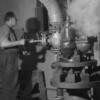Consensus Not Whole Story | Mirage News
Technology tamfitronics
Uppsala University
Twentieth-century Swedish labour market policy was not solely shaped by inter-class cooperation, but also by tough conflicts between employers and employees, as industrial rationalisation and investments in new technology were met with protests from workers. As a new doctoral thesis in the field of economic history shows, this led to a tug-of-war within Swedish industry over how new technology should be deployed and how work should be organised.
“The image of the twentieth-century Swedish labour market as exceptionally cooperative is false. Even after the Saltsjöbaden Agreement of 1938, there were many conflicts between workers and employers, often fuelled by technological change. These disputes influenced the shape of what we now know as the Swedish model,” says Arvand Mirsafian, who recently defended his thesis in economic history.
In his thesis, Mirsafian examines how factory workers responded to the rationalisation and restructuring of industry and the labour market during the period 1920-1950. More specifically, he describes how critical technological shifts affected members of the metalworkers’ union, Metall, and how this in turn led to industrial action that shaped the Swedish labour market model.
Among other sources, the study is based on material in the archives of Metall, the Swedish Trade Union Confederation, local trade union branches and the newspapers of the labour movement. By doing so, Mirsafian was able to study how views of rationalisation differed within the trade union movement, and how the internal debate influenced the institutional framework of labour market policy.
While there was a strong desire for cooperation between the labour market parties at central level, the reality was very different on the shopfloor, where the workers viewed rationalisation as a potential threat to their working conditions and autonomy. During this period, the metalworkers’ protests became an important factor shaping the trade union movement’s policies and industrial relations.
“While the leaders of the trade union movement were aware that technological change might lead to more extensive cooperation with business owners, their members were convinced that employers were exploiting new technology to both keep wages down and increase productivity,” says Mirsafian.
One significant event during the period was the metalworkers’ strike of 1945, which in part at least was a response to rationalisation. Over 120,000 metalworkers took industrial action. The strike resulted in both new collective agreements and new institutions to regulate the use of technology in industry and cooperation between the labour market parties, with the aim of ensuring that technological change would benefit both sides. The strike influenced the emergent economic policy of the trade union movement as a whole.
Mirsafian’s research reveals parallels between technological changes during the interwar years and 1940s and the transition we face today with, for example, artificial intelligence and automation.
“Technological change has always meant a renegotiation of the balance of power in the labour market. The developments we are witnessing today are no exception. There is no such thing as politically neutral technology; it is shaped by various societal interests. History can give us a better understanding of how present-day society can manage the challenges posed by technological change,” says Mirsafian.
Doctoral thesis: Mirsafian, Arvand: Workers and technology: Swedish trade unionism, rationalization and labor market policy 1920-1950; (English: Workers and Technology : Trade Unionism, Rationalization, and Labour Market Policy in Sweden 1920-1950) Acta Universitatis Upsaliensis, 2024, ISBN: 978-91-513-2123-3, https://urn.kb.se/resolve?urn=urn:nbn:se:uu:diva-526637
/Public Release. This material from the originating organization/author(s) might be of the point-in-time nature, and edited for clarity, style and length. Mirage.News does not take institutional positions or sides, and all views, positions, and conclusions expressed herein are solely those of the author(s).View in full here.
Discover more from Tamfis
Subscribe to get the latest posts sent to your email.

